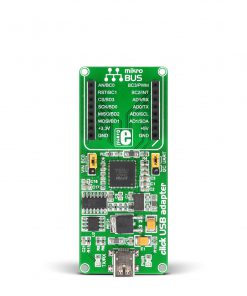click USB adapter
R635.00 ex. VAT
click USB adapter is a compact Shield board that provides the necessary interface for connecting Click boards™ to your PC through the USB connection. This board features the FT2232H, a dual high-speed USB to a multipurpose UART/FIFO IC from FTDI Chip. The click USB adapter allows Click boards™ with SPI, I2C, UART, and other interfaces to communicate with the computer equipped with the standard USB interface. This shield makes the perfect solution for secure and reliable connection of the Click boards™ to your PC through a high-speed USB connection, without the need for a microcontroller as a mediator.
click USB adapter can be especially interesting for the development systems that are not equipped with a mikroBUS™ socket, such as personal computers, Raspberry Pi’s, similar SBCs, and others. Using the click USB adapter on such systems will significantly improve its usability by adding a mikroBUS™ socket. This click USB adapter is a fully tested product, ready for use on a system equipped with the standard USB interface.
Stock: Lead-time applicable.
| 5+ | R603.25 |
| 10+ | R571.50 |
| 15+ | R539.75 |
| 20+ | R519.43 |


















